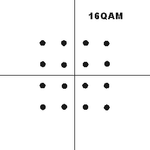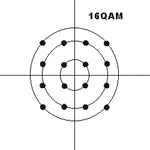ashugtiwari
Full Member level 4
Hello All,
Ok, i may be asking dumb question but by far my knowledge of communication systems is rudimentary. So, sorry if i make any silly statement.
Im trying to understand 16 - QAM signal. Since, I could not figure out from whatever i found on google. So, according to ideal modulator, dividing a byte into 4 bit values such that odd positioned bits will form Q component and even positioned bits in byte will form I component. Then the 4 bit values will modulate the sine and cosine component and will generate final I and Q component, then the final result is added together and transmitted on channel.
Is this the way QAM is generated or the method is different for digital 16 QAM? Since, when i saw constellation diagram i got confused that, only three voltage levels and 16 values, so the 12 different phase positions will make up for it. But how? Since, every 4 bit value will have its own amplitude value.
In a way, im bit confused. Sorry, for such basic question, but i could not find any satisfactory answer.
Thanks for answers.
Ashutosh
Ok, i may be asking dumb question but by far my knowledge of communication systems is rudimentary. So, sorry if i make any silly statement.
Im trying to understand 16 - QAM signal. Since, I could not figure out from whatever i found on google. So, according to ideal modulator, dividing a byte into 4 bit values such that odd positioned bits will form Q component and even positioned bits in byte will form I component. Then the 4 bit values will modulate the sine and cosine component and will generate final I and Q component, then the final result is added together and transmitted on channel.
Is this the way QAM is generated or the method is different for digital 16 QAM? Since, when i saw constellation diagram i got confused that, only three voltage levels and 16 values, so the 12 different phase positions will make up for it. But how? Since, every 4 bit value will have its own amplitude value.
In a way, im bit confused. Sorry, for such basic question, but i could not find any satisfactory answer.
Thanks for answers.
Ashutosh

